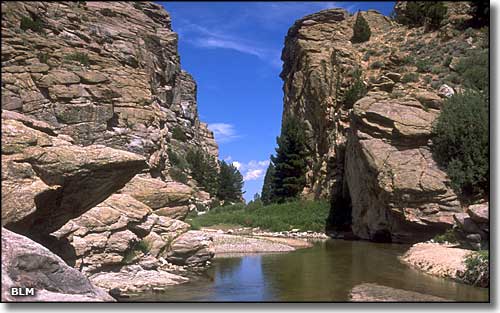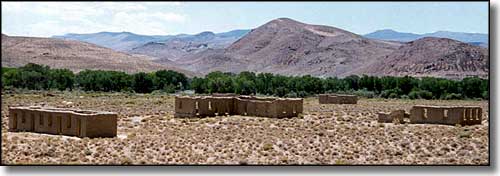 |
Pony Express National Historic Trail |
|
|
 Devil's Gate, a landmark along the Pony Express Trail on the Sweetwater River in central Wyoming |
|
Between 1820 and 1860, about 1/2 million American emigrants had moved westward, most almost all the way to the Pacific Coast. A big thing missing in their lives was up-to-date news from home. A message sent to California by President James K. Polk took six months to get there in 1845. Over time that delivery lag got shorter but with the mail being carried by wagon train or stagecoach... In 1847 Congress established postal service to the Pacific Coast. In 1851 the rate to send a half-ounce letter up to 3,000 miles was $0.03, and $0.06 if the letter went further. Mail delivery was handled by private contractors and the whole thing ran on huge government subsidies and it still took a couple months to get a letter from the East Coast to the West Coast. The Pacific Mail Steamship Company was awarded a contract in 1848 to carry mail to California. Their route involved shipping mail from New York to Panama by boat, crossing the Isthmus of Panama on a train and then shipping on a boat again to San Francisco. It still took 3, 4 and sometimes more weeks to arrive in California. In 1855, Congress devoted $30,000 to an experiment to see if camels could carry the mail from Texas to California and arrive in a decent time frame. It didn't work. Then John Butterfield of the famous Butterfield Stage Company got a $600,000 contract in 1857 to deliver the mail from Fort Smith, Arkansas through El Paso and Yuma to San Francisco in 25 days or less. That was a 2,800-mile route that the Butterfield Overland Stagecoach Service began in 1858. That service was working successfully until the advent of the Civil War. At that point, a more northern route was required, even though a northern route would have to cross mountain passes that were often snowbound. William H. Russell of the freighting firm Russell, Majors & Waddell then made the fateful decision to commit to a central overland delivery route using relays of horses and riders. He and his 2 partners formed the Central Overland California & Pike's Peak Express Company - the official name of the Pony Express. While Russell raised money and political support for the venture, Majors put together the daily operations and Waddell ran the home office. From the day they started they had 67 days to hire men, buy horses, food and supplies, and distribute the whole to stations (some that hadn't even been built yet) across a route that hadn't even been determined yet. |
 Stagecoach Inn, near Camp Floyd in Fairfield, Utah, a Pony Express rest stop |
|
When the enterprise truly got under way, things were better organized. Every 75 to 100 miles was a home station where riders and horses were housed. Every 10 to 15 miles in between were smaller relay stations where riders would stop and exchange horses for the next leg of the trip. On the first run, there were 86 stations along the route. By mid-1861 that had been expanded to 147 stations. And the route itself was broken into 5 sections. The beginning leg ran from St. Joseph, Missouri to Fort Kearny, Nebraska along the route of the Oregon and California Trails. The second leg also followed these venerable trails from Fort Kearny to Horseshoe Station near Fort Laramie in Wyoming Territory. The third leg followed the Moron Pioneer Trail from Horseshoe Station through Fort Bridger and into the Salt Lake Valley of Utah. The fourth leg followed a route established by James Simpson in 1858 that went south of the Great Salt Lake to Roberts Creek Station, in the hills north of what is now Eureka, Nevada. The final leg of the route ran from Roberts Creek across the central Nevada desert and then crossed the Sierra Nevada Mountains before arriving in Sacramento and San Francisco. The "men" hired for the job of Pony Express Rider varied in age from their mid-teens to about 40. They had to weigh less than 120 pounds and had to be able to carry 25 pounds of equipment and 20 pounds of mail with them on horseback. On being hired they also took an oath: "While I am in the employ of A. Majors, I agree not to use profane language, not to get drunk, not to gamble, not to treat animals cruelly, and not to do anything else that is incompatible with the conduct of a gentleman. And I agree, if I violate any of the above conditions, to accept my discharge without any pay for my services." For their services they were paid $50 per month, plus room and board. Of the 80-to-100 riders and several hundred station hands employed, not all lived up to that oath. One Division Superintendent, a Jack Slade, was known to be quite wild when drunk but he did keep "the road cleared of robbers and horse thieves." There was also an incident at Rock Creek Station in Nebraska where James Butler "Wild Bill" Hickock (the Assistant Station Tender) shot agent David McCanles and 2 others. As for "Buffalo Bill" Cody, he never did ride for the Pony Express, even though he promoted them through his famous Wild West Show. The horses: the company bought between 400 and 500 horses, many thoroughbreds for the eastern legs of the route and many California mustangs for the western sections. A rider would typically ride 75 to 100 miles of route and change horses 8 to 10 times along the way. They carried the mail in a leather knapsack (mochila) that had 4 locked leather boxes sewn into its corners. The mochila was designed to make transfer from one horse to the next very quick, although the riders would often stop to stretch their legs and get a drink or bite to eat before taking off on the next section of their route. The first westbound rider left St. Joseph, Missouri at 7:15 pm on April 3, 1860. The first eastbound rider had left San Francisco on a paddle steamer headed for Sacramento at 4 pm the same day. The next morning that eastbound mochila passed over the Sierra Nevada's in a raging blizzard. The eastbound and westbound mochilas passed each other west of today's Farson, Wyoming on April 8. The eastbound mail reached St. Joseph on April 13 while the westbound mail reached San Francisco about 1 am on April 14. The event was of such proportions that at both ends of the route, the riders were greeted by thousands of cheering people and several marching bands. |
 Fort Churchill, Nevada, a Pony Express stop near Bucklands Station |
|
At first, the postage fee was $5 per half-ounce of mail, but that was later reduced to $1. In the beginning, the route was ridden once a week in both directions but in July 1860, they started running twice a week. The only interruption in service happened from May to late June 1860 during a Paiute uprising in Nevada. It had been a bad winter that year and the Paiutes were starving. They blamed a lot of their condition on the thousands of gold-seeking miners that had destroyed the Paiutes' food and water sources in their insatiable thirst for gold. As tensions grew, the Pony Express became a target and the Paiutes burned stations to the ground, driving off the horses and killing the employees. The Pony Express was already struggling financially and this almost killed it. However, the biggest problem to the fledgling company wasn't the Indians, it was winter weather in the Sierra's and on that leg of the route between Salt Lake and Fort Laramie. Then it came to light that Russell, Majors & Waddell was essentially bankrupt when they first launched the Pony Express. Russell had gambled on the Pony Express contract reviving their fortunes but Congress adjourned in June 1860 without taking an action on approving the contract (and authorizing the funding). Russell started secretly borrowing bonds through a friend in a different government agency but that became public news in December 1860. Russell was immediately arrested and charged with embezzlement, but he beat that in court. Then came the opening shots of the Civil War and Congress finally authorized money for an overland mail delivery program, only they gave the contract to Butterfield to establish a more northern route for his stage company and left the Pony Express hanging in the breeze... While the last run of the Pony Express was completed on November 20, 1861, the company had officially ceased operations on October 26, 1861, the same day the transcontinental telegraph was completed and the first messages successfully sent and received. Every year since 1978, there is an event sponsored by the National Pony Express Association where more than 500 riders follow the original route as closely as they can in a 10-day, non-stop, round-the-clock ride. Only these days, they keep track of each other with cell phones and short wave radios... |
|
|

|
| Index - Arizona - Colorado - Idaho - Montana - Nevada - New Mexico - Utah - Wyoming National Forests - National Parks - Scenic Byways - Ski & Snowboard Areas - BLM Sites Wilderness Areas - National Wildlife Refuges - National Trails - Rural Life Advertise With Us - About This Site - Privacy Policy |
| Photo of Devil's Gate courtesy of the Bureau of Land Management Photo of Stagecoach Inn at Fairfield, Utah courtesy of David Jolley, CCA ShareAlike 3.0 License. Photo of Fort Churchill courtesy of Nevada State Parks Map of the Pony Express National Historic Trail courtesy of the National Park Service and Bureau of Land Management. Text Copyright © by Sangres.com. All rights reserved. |